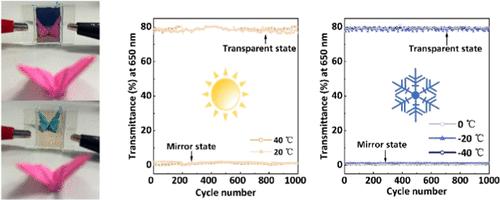当前位置:
X-MOL 学术
›
J. Phys. Chem. C
›
论文详情
Our official English website, www.x-mol.net, welcomes your feedback! (Note: you will need to create a separate account there.)
Aprotic Polar Electrolyte Facilitates Indoor Dynamic Optical-Thermal Management in Silver-Based Electro-Reflective Smart Windows
The Journal of Physical Chemistry C ( IF 3.7 ) Pub Date : 2024-03-26 , DOI: 10.1021/acs.jpcc.4c00846 Jinchao Zhang 1 , Xin Jiang 1 , Meng Yuan 2 , Anqing Xu 1 , Xin Tang 1 , Long Yuan 3 , Yu Duan 1
The Journal of Physical Chemistry C ( IF 3.7 ) Pub Date : 2024-03-26 , DOI: 10.1021/acs.jpcc.4c00846 Jinchao Zhang 1 , Xin Jiang 1 , Meng Yuan 2 , Anqing Xu 1 , Xin Tang 1 , Long Yuan 3 , Yu Duan 1
Affiliation

|
The electrochromic devices explored in this study show tremendous promise for energy conservation, enabling active, adaptive control of solar heat and lighting in buildings. However, a majority of existing devices fail to perform optimally in areas with significant temperature fluctuations. Addressing this challenge, we introduce a new aprotic polar electrolyte (APE) for use in a reversible silver deposition electrochromic device. This novel device boasts an impressive ability to switch from a highly transparent state (with light transmittance at 650 nm being equal to or greater than 80%) to a reflective mirror-like state (with light transmittance at 650 nm being equal to or less than 1%) across an extensive temperature range spanning from −40 to 40 °C. The device’s switching threshold decreases with lower temperatures, moving from −1.97 V at 40 °C to −2.37 V at −40 °C. The coloration process completes in as swift as 3.5 s at 40 °C and in 13.6 s at −40 °C, while the bleaching process requires 16.3 s at 40 °C and extends to 71.0 s at −40 °C. Achieving high optical contrast (with a ΔT = 80% at 650 nm) at varied temperatures, the device also demonstrates exceptional durability across numerous cycles.
中文翻译:

非质子极性电解质促进银基电反射智能窗户的室内动态光热管理
本研究中探索的电致变色器件在节能方面显示出巨大的前景,能够对建筑物中的太阳热和照明进行主动、自适应控制。然而,大多数现有设备无法在温度波动较大的地区发挥最佳性能。为了解决这一挑战,我们推出了一种新型非质子极性电解质(APE),用于可逆银沉积电致变色器件。这种新颖的器件具有从高透明状态(650 nm处的透光率等于或大于80%)到反射镜状状态(650 nm处的透光率等于或小于80%)的令人印象深刻的能力。 1%),覆盖-40至40°C的广泛温度范围。该器件的开关阈值随着温度的降低而降低,从 40 °C 时的 -1.97 V 变为 -40 °C 时的 -2.37 V。着色过程在 40 °C 下仅需 3.5 s,在 -40 °C 下仅需 13.6 s,而漂白过程在 40 °C 下需要 16.3 s,在 -40 °C 下需要 71.0 s。该器件在不同温度下可实现高光学对比度(650 nm 处 Δ T = 80%),并且在多次循环中也表现出卓越的耐用性。
更新日期:2024-03-26
中文翻译:

非质子极性电解质促进银基电反射智能窗户的室内动态光热管理
本研究中探索的电致变色器件在节能方面显示出巨大的前景,能够对建筑物中的太阳热和照明进行主动、自适应控制。然而,大多数现有设备无法在温度波动较大的地区发挥最佳性能。为了解决这一挑战,我们推出了一种新型非质子极性电解质(APE),用于可逆银沉积电致变色器件。这种新颖的器件具有从高透明状态(650 nm处的透光率等于或大于80%)到反射镜状状态(650 nm处的透光率等于或小于80%)的令人印象深刻的能力。 1%),覆盖-40至40°C的广泛温度范围。该器件的开关阈值随着温度的降低而降低,从 40 °C 时的 -1.97 V 变为 -40 °C 时的 -2.37 V。着色过程在 40 °C 下仅需 3.5 s,在 -40 °C 下仅需 13.6 s,而漂白过程在 40 °C 下需要 16.3 s,在 -40 °C 下需要 71.0 s。该器件在不同温度下可实现高光学对比度(650 nm 处 Δ T = 80%),并且在多次循环中也表现出卓越的耐用性。



























 京公网安备 11010802027423号
京公网安备 11010802027423号